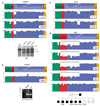Characterization of large rearrangements in autosomal dominant polycystic kidney disease and the PKD1/TSC2 contiguous gene syndrome
- PMID: 18818683
- PMCID: PMC2756756
- DOI: 10.1038/ki.2008.485
Characterization of large rearrangements in autosomal dominant polycystic kidney disease and the PKD1/TSC2 contiguous gene syndrome
Abstract
Large DNA rearrangements account for about 8% of disease mutations and are more common in duplicated genomic regions, where they are difficult to detect. Autosomal dominant polycystic kidney disease (ADPKD) is caused by mutations in either PKD1 or PKD2. PKD1 is located in an intrachromosomally duplicated region. A tuberous sclerosis gene, TSC2, lies immediately adjacent to PKD1 and large deletions can result in the PKD1/TSC2 contiguous gene deletion syndrome. To rapidly identify large rearrangements, a multiplex ligation-dependent probe amplification assay was developed employing base-pair differences between PKD1 and the six pseudogenes to generate PKD1-specific probes. All changes in a set of 25 previously defined deletions in PKD1, PKD2 and PKD1/TSC2 were detected by this assay and we also found 14 new mutations at these loci. About 4% of the ADPKD patients in the CRISP study were found to have gross rearrangements, and these accounted for about a third of base-pair mutation negative families. Sensitivity of the assay showed that about 40% of PKD1/TSC contiguous gene deletion syndrome families contained mosaic cases. Characterization of a family found to be mosaic for a PKD1 deletion is discussed here to illustrate family risk and donor selection considerations. Our assay improves detection levels and the reliability of molecular testing of patients with ADPKD.
Figures







References
-
- Torres VE, Harris PC, Pirson Y. Autosomal dominant polycystic kidney disease. Lancet. 2007;369:1287–1301. - PubMed
-
- European Polycystic Kidney Disease Consortium. The polycystic kidney disease 1 gene encodes a 14 kb transcript and lies within a duplicated region on chromosome 16. Cell. 1994;77:881–894. - PubMed
-
- Hughes J, Ward CJ, Peral B, et al. The polycystic kidney disease 1 (PKD1) gene encodes a novel protein with multiple cell recognition domains. Nat Genet. 1995;10:151–160. - PubMed
-
- Mochizuki T, Wu G, Hayashi T, et al. PKD2, a gene for polycystic kidney disease that encodes an integral membrane protein. Science. 1996;272:1339–1342. - PubMed
-
- Rossetti S, Consugar MB, Chapman AB, et al. Comprehensive molecular diagnostics in autosomal dominant polycystic kidney disease. J Am Soc Nephrol. 2007;18:2143–2160. - PubMed
Publication types
MeSH terms
Substances
Grants and funding
LinkOut - more resources
Full Text Sources
Other Literature Sources
Miscellaneous

